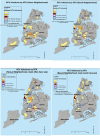Prevalence and mapping of hepatitis C infections among men who have sex with men in New York City
- PMID: 30020960
- PMCID: PMC6051624
- DOI: 10.1371/journal.pone.0200269
Prevalence and mapping of hepatitis C infections among men who have sex with men in New York City
Abstract
Emerging sexually transmitted hepatitis C virus (HCV) epidemics among men who have sex with men (MSM) have been reported worldwide, with higher HCV infection rates among those who are HIV-infected. This study aims to determine prevalence of recent and chronic HCV infections among community-recruited MSM in New York City (NYC), map HCV infections by home, social, and sexual neighborhoods, and identify clusters of genetically linked HCV variants using phylogenetic analysis. The NYC M2M study recruited MSM via modified time-space, venue-based sampling and internet/mobile app-based recruitment during 2010-13. Participants completed a Google Earth map on neighborhoods of where they lived, socialized, and had sex in the last 3 months, an ACASI questionnaire, and a sexual network inventory about their sex partners. The men received HIV testing and provided serum samples. Testing on stored serum samples included HCV antibody and RNA viral load, HCV antibody avidity assay (avidity index <30% with positive viral load is considered recently infected), and HCV RNA extraction and amplification to generate a 432 base-pair region of Core/E1 for sequencing and phylogenetic analysis. Historic local controls were included in the phylogenetic analysis. Of 1,028 MSM, 79.7% were HIV-negative and 20.3% HIV-positive. Twenty nine MSM (2.8%) were HCV antibody-positive. MSM who were HCV antibody-positive reported a median of 2 male sex partners in last 3 months, with 6.9% aged 18-24, 17.2% 25-29, 13.8% 30-39, and 62.1% 40 and over. 8.1% of HIV-positive MSM were HCV antibody-positive vs. 1.5% of HIV-negative men (p<0.0001). Of 29 HCV-antibody positive MSM, 12 (41%) were HCV RNA-positive (11 subtype 1a and 1 subtype 1b). Two of 12 HCV RNA-positive participants had low antibody avidity values, suggesting recent HCV infection. HCV antibody seropositivity was significantly associated with older age >40 years, adjusted odds ratio (aOR) 3.56 (95% CI 1.57, 8.08), HIV-positive serostatus, aOR 3.18 (95% CI 1.40, 7.22), any sexually transmitted infection (STI) in the last 3 months, aOR 2.81 (95% CI 1.11, 7.13), and injection drug use (IDU) ever, aOR 4.34 (95% CI 1.69, 11.17). Mapping of HCV infections differed slightly by home, social, and sexual neighborhoods. Based on phylogenetic analysis from 12 HCV RNA-positive samples, no evidence of a clustered HCV epidemic was found. Overall HCV seroprevalence was 2.8% among community-recruited MSM in NYC, with higher prevalence among HIV-positive MSM compared to HIV-negative MSM. Only two participants were found to have recent HCV infection, with no evidence of a clustered HCV epidemic based on phylogenetic analysis. Our results support testing of HCV infection among HIV-negative MSM if they report having a recent STI and IDU in the past rather than universal HCV testing in all HIV-negative MSM.
Conflict of interest statement
The research grant support from Merck Investigators Studies Program does not alter our adherence to PLOS ONE policies on sharing data and materials. The commercial affiliation of a coauthor with Bioinfoexperts, LLC does not alter our adherence to PLOS ONE policies on sharing data and materials.
Figures
Similar articles
-
Sexually transmitted hepatitis C virus infections: current trends, and recent advances in understanding the spread in men who have sex with men.J Int AIDS Soc. 2019 Aug;22 Suppl 6(Suppl Suppl 6):e25348. doi: 10.1002/jia2.25348. J Int AIDS Soc. 2019. PMID: 31468692 Free PMC article.
-
Prevalence of hepatitis C infection, screening and associated factors among men who have sex with men attending gay venues: a cross-sectional survey (PREVAGAY), France, 2015.BMC Infect Dis. 2019 Apr 11;19(1):315. doi: 10.1186/s12879-019-3945-z. BMC Infect Dis. 2019. PMID: 30971207 Free PMC article.
-
Low prevalence of hepatitis C co-infection in recently HIV-infected minority men who have sex with men in Los Angeles: a cross-sectional study.BMC Infect Dis. 2015 Nov 20;15:538. doi: 10.1186/s12879-015-1279-z. BMC Infect Dis. 2015. PMID: 26590028 Free PMC article.
-
High incidence of HCV in HIV-negative men who have sex with men using pre-exposure prophylaxis.J Hepatol. 2020 May;72(5):855-864. doi: 10.1016/j.jhep.2019.11.022. Epub 2019 Dec 18. J Hepatol. 2020. PMID: 31862485
-
Prevalence and incidence of hepatitis C virus infection in men who have sex with men: a systematic review and meta-analysis.Lancet Gastroenterol Hepatol. 2021 Jan;6(1):39-56. doi: 10.1016/S2468-1253(20)30303-4. Epub 2020 Nov 18. Lancet Gastroenterol Hepatol. 2021. PMID: 33217341
Cited by
-
A latent class approach to identify multi-risk profiles associated with phylogenetic clustering of recent hepatitis C virus infection in Australia and New Zealand from 2004 to 2015.J Int AIDS Soc. 2019 Feb;22(2):e25222. doi: 10.1002/jia2.25222. J Int AIDS Soc. 2019. PMID: 30746864 Free PMC article.
-
A Web-Based Audio Computer-Assisted Self-interview Application With Illustrated Pictures to Administer a Hepatitis B Survey Among a Myanmar-Born Community in Perth, Australia: Development and User Acceptance Study.JMIR Form Res. 2023 Apr 14;7:e37358. doi: 10.2196/37358. JMIR Form Res. 2023. PMID: 37058345 Free PMC article.
-
Intersecting Epidemics: Incident Syphilis and Drug Use in Women Living With Human Immunodeficiency Virus in the United States (2005-2016).Clin Infect Dis. 2020 Dec 3;71(9):2405-2413. doi: 10.1093/cid/ciz1108. Clin Infect Dis. 2020. PMID: 31712815 Free PMC article.
-
Health disparities experienced by sexual and gender minority individuals living with or at risk of chronic liver disease.Clin Liver Dis (Hoboken). 2023 Sep 14;22(4):152-156. doi: 10.1097/CLD.0000000000000073. eCollection 2023 Oct. Clin Liver Dis (Hoboken). 2023. PMID: 37908866 Free PMC article. Review. No abstract available.
-
Sexually transmitted hepatitis C virus infections: current trends, and recent advances in understanding the spread in men who have sex with men.J Int AIDS Soc. 2019 Aug;22 Suppl 6(Suppl Suppl 6):e25348. doi: 10.1002/jia2.25348. J Int AIDS Soc. 2019. PMID: 31468692 Free PMC article.
References
Publication types
MeSH terms
Substances
Grants and funding
LinkOut - more resources
Full Text Sources
Other Literature Sources
Medical
Miscellaneous



